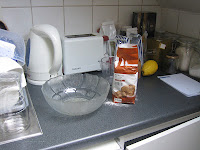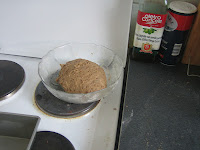
I love baking bread. I love the feel of the dough in my fingers. It's much the same reason that, when I make a cake, I enjoy beating all the ingredients by hand - the world disappears for a few minutes, and I get to watch all the chemical changes in the batter.
I am far from an expert, so this is not a tutorial, but for those of you living in Belgium, there is a fairly fool-proof option. Colruyt does these handy little packets of bread flour - 500g - with dried yeast mixed in. They cost around one Euro, and there are instructions on the box, but basically you just add water and a pinch of salt.
 You can play around with it a bit - I thoroughly recommend adding some kind of oil or butter, and I have had great fun adding various kinds of seed, spice and nut. I have also successfully added milk, eggs, beer, grated cheese and honey.
You can play around with it a bit - I thoroughly recommend adding some kind of oil or butter, and I have had great fun adding various kinds of seed, spice and nut. I have also successfully added milk, eggs, beer, grated cheese and honey.
Then you knead it like a mofo. You want all the gluten aligned, a nice doughy texture. Leave it to rise, then push out the air, shape, and put in the tin. Leave it to rise a bit more, then into the oven. When it comes out of the oven, knock it on the bottom - if it sounds hollow, it's done. You can also leave it to rise several times - the longer you leave it at this stage, the more the yeast is breaking down the gluten into its nummy nutritious bits.
 If you bake bread, you will quickly discover that the time of year makes a big difference - the ambient temperature dictates how quickly the bread rises. In winter, I need to turn the oven on and leave the bread on top to get any kind of rise, but in the summer I can just leave it on the side. Perhaps the first hint of becoming more aware of the impact of the changing seasons?
If you bake bread, you will quickly discover that the time of year makes a big difference - the ambient temperature dictates how quickly the bread rises. In winter, I need to turn the oven on and leave the bread on top to get any kind of rise, but in the summer I can just leave it on the side. Perhaps the first hint of becoming more aware of the impact of the changing seasons?
Of course, you can bake your bread in a loaf tin like this, or just loose, or make a cottage roll - the variations are endless. My favourite bread recipe ever is definitely this beer and cheese bread. Seriously, yum does not even cover it.
 I find that sandwiches made from homemade bread are considerably more filling than bought bread, and my digestive system thanks me too - much less stodgy! Interestingly, gluten intolerance has risen dramatically since we started using the Chorleywood Bread Process - used for making bread on an industrial scale, involving lower grade gluten, more sugar and more yeast to make the bread rise faster. Possible connection?
I find that sandwiches made from homemade bread are considerably more filling than bought bread, and my digestive system thanks me too - much less stodgy! Interestingly, gluten intolerance has risen dramatically since we started using the Chorleywood Bread Process - used for making bread on an industrial scale, involving lower grade gluten, more sugar and more yeast to make the bread rise faster. Possible connection?
The biggest challenge for me is finding the time and rhythm to make bread regularly - in short, to replace bought bread with homemade. I make it sporadically, rather than regularly. Perhaps, for June, I should challenge myself to eat only homemade bread?
Ta da! The finished loaf, ready for slicing.


No comments:
Post a Comment